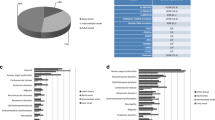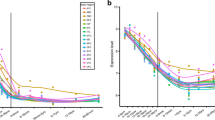Abstract
Despite that mutations in mitochondrial DNA (mtDNA) have been associated with major epilepsy syndromes, the role of mtDNA instability and mitochondrial dysfunction in epileptogenesis has not been comprehensively examined. In the present study, we investigated the role of mtDNA copy number, oxidative damage, and mtDNA variants as independent or combined risk factors for the development of intractable childhood epilepsy. We analyzed mtDNA copy number and oxidative damage by quantitative polymerase chain reaction (PCR), and mtDNA variants by dot blot in brain tissue specimens collected from 21 pediatric intractable epilepsy patients and 11 non-epileptic patients. Bayesian network and mechanistic hierarchical structure Markov chain Monte Carlo (MCMC) modeling were used to analyze the relationship between these variables. The combined effects of oxidative mtDNA damages and mtDNA copy number produced more significant correlation with epilepsy than that of mtDNA copy number alone with epilepsy. Epilepsy patients showed significant correlations with mtDNA single nucleotide polymorphisms (SNPs) — A1555G, G3196A, T3197C, G9952A, A10006G, A10398G, cortical dysplasia status, oxidative mtDNA damage and relative mtDNA copy number. Comparison of 12 mechanistic structure models suggested that female children who have the wild type allele 10398A and variant allele 9952A, and high mtDNA copy number and oxidative stress have increased probability of developing intractable epilepsy. Estimation of nuclear genes controlling mitochondrial biogenesis, cortical dysplasia, and the effect of the environment using MCMC method showed that these latent variables had a very significant contribution in the development of intractable epilepsy. These data suggest that mitochondrial genetics play a significant role in the pathogenesis of epilepsy in children, and findings of this study may guide the prospects for targeting mitochondria for therapeutic treatment of childhood intractable epilepsy.



Similar content being viewed by others
References
Andres M, Andre VM, Nguyen S, Salamon N, Cepeda C, Levine MS, Leite JP, Neder L, Vinters HV, Mathern GW (2005) Human cortical dysplasia and epilepsy: an ontogenetic hypothesis based on volumetric MRI and NeuN neuronal density and size measurements. Cereb Cortex 15:194–210
Ayala-Torres S, Chen Y, Svoboda T, Rosenblatt J, Van Houten B (2000) Analysis of gene-specific DNA damage and repair using quantitative polymerase chain reaction. Methods 22:135–147
Bai RK, Leal SM, Covarrubias D, Liu A, Wong LJ (2007) Mitochondrial genetic background modifies breast cancer risk. Cancer Res 67:4687–4694
Bai R, Wong L, Leal SM (2008) Mitochondrial DNA variant interactions modify breast cancer risk. J Hum Genet 53:924–928
Barkovich AJ, Kuzniecky RI, Jackson GD, Guerrini R, Dobyns WB (2005) A developmental and genetic classification for malformations of cortical development. Neurology 65:1873–1887
Baron M, Kudin A, Kunz W (2007) Mitochondrial dysfunction in neurodegenerative disorders. Biochem Soc Trans 35:1228–1231
Bindoff LA, Engelsen BA (2012) Mitochondrial diseases and epilepsy. Epilepsia 53(suppl 4):92–97
Brinckmann A, Weiss C, Wilbert F, von Moers A, Zwirner A, Stoltenburg-Didinger G, Wilichowski E, Schuelke M (2010) Regionalized pathology correlates with augmentations of mtDNA copy numbers in patients with myoclonic epilepsy with ragged-red fibers (MERRF-Syndrome). PLoS ONE 5:e13513
Canafoglia L, Franceschetti S, Antozzi C, Carrara F, Farina L, Granata T, Lamantea E, Savoiardo M, Uziel G, Villani F, Zeviani M, Avanzini G (2001) Epileptic phenotypes associated with mitochondrial disorders. J Neurol 56:1340–1346
Cardaioli E, Dotti MT, Hayek G, Zappella M, Federico A (1999) Studies on mitochondrial pathogenesis of Rett syndrome: ultrastructural data from skin and muscle biopsies and mutational analysis at mtDNA nucleotides 10463 and 2835. J Submicrosc Cytol Pathol 31:301–304
Chen C, Wu Y, Cheng M, Liu JL, Lee YM, Lee PW, Soong BW, Chiu DT (2007) Increased oxidative damage and mitochondrial abnormalities in the peripheral blood of Huntington’s disease patients. Biochem Biophys Res Commun 359:335–340
Chinnery PF, Hudson G (2013) Mitochondrial genetics. Br Med Bull 106:135–159
DiMauro S (2001) Lessons from mitochondrial DNA mutations. Semin Cell Dev Biol 9:397–405
El Sabbagh S, Lebre A-S, Bahi-Buisson N, Delonlay P, Soufflet C, Boddaert N, Rio M, Rçtig A, Dulac O, Munnich A, Desguerre I (2010) Epileptic phenotypes in children with respiratory chain disorders. Epilepsia 51:1225–1235
Felty Q, Roy D (2005) Estrogen, mitochondria, and growth of cancer and non-cancer cells. J Carcinog 4:e1
Filiano JJ, Goldenthal MJ, Rhodes H, Marín-García J (2002) Mitochondrial dysfunction in patients with hypotonia, epilepsy, autism, and developmental delay: HEADD syndrome. J Child Neurol 17:435–439
Fukuda M, Yamauchi H, Yamamoto H, Aminakab M, Murakamia H, Kamiyamaa N, Miyamotoa Y, Koitabashia Y (2008) The evaluation of oxidative DNA damage in children with brain damage using 8-hydroxyguanosine levels. Brain Dev 30:131–136
Geman S, Geman D (1984) Stochastic relaxation, Gibbs distributions and the Bayesian restoration of images. IEEE Trans Pattern Anal Mach Intell 6:721–742
Grazina M, Pratas J, Silva F, Oliveira S, Santana I, Oliveira C (2006) Genetic basis of Alzheimer’s dementia: role of mtDNA mutations. Genes Brain Behav 5(Suppl 2):92–107
Hader WJ, Mackay M, Otsubo H, Chitoku S, Weiss S, Becker L, Snead OC 3rd, Rutka JT (2004) Cortical dysplastic lesions in children with intractable epilepsy: role of complete resection. J Neurosurg 100:110–117
Hanna M, Nelson P, Rahman S, Lane RJM, Land L, Heales S, Cooper MJ, Schapira AHV, Morgan-Hughes JA, Wood NW (1998) Cytochrome c oxidase deficiency associated with the first stop-codon point mutation in human mtDNA. Am J Genet 63:29–36
Howell N, Oostra R, Bolhuis P, Spruijt L, Clarke LA, Mackey DA, Preston G, Herrnstadt C (2003) Sequence analysis of the mitochondrial genomes from Dutch pedigrees with Leber Hereditary Optic Neuropathy. Am J Genet 72:1460–1469
Hsieh RH, Li J-Y, Pang C-Y, Wei Y-H (2001) A novel mutation in the mitochondrial 16S rRNA gene in a patient with MELAS syndrome, diabetes mellitus, hyperthyroidism and cardiomyopathy. J Biomed Sci 8:328–335
Hua Y, Crino PB (2003) Single cell lineage analysis in human focal cortical dysplasia. Cereb Cortex 13:693–699
MITOMAP: A Human Mitochondrial Genome Database (2009) http://www.mitomap.org/MITOMAP.
Jizong Z, Zhou F, Hongmin B (2011) Surgical treatment of intractable epilepsy associated with focal cortical dysplasia. In Humberto Foyaca-Sibat (Ed.) Novel treatment of epilepsy, ISBN: 978-953-307-667-6: http://www.intechopen.com/books/novel-treatment-of-epilepsy/surgicaltreatment-of-intractable-epilepsy-associated-with-focal-cortical-dysplasia
Kunkle BW, Yoo C, Roy D (2013) Reverse engineering of modified genes by Bayesian Network analysis defines molecular determinants critical to the development of glioblastoma. PLoS ONE 8(5):e64140
Lee H, Wei Y (2005) Mitochondrial biogenesis and mitochondrial DNA maintenance of mammalian cells under oxidative stress. Int J Biochem Cell Biol 37:822–834
Lee H, Yin P, Lu C, Chi CW, Wei YH (2000) Increase of mitochondria and mitochondrial DNA in response to oxidative stress in human cells. Biochem J 348:425–432
Lee J, Park K, Im J, Kim MY, Lee DC (2010) Mitochondrial DNA copy number in peripheral blood associated with cognitive function in apparently healthy elderly women. Clin Chim Acta 411:592–596
Lehtonen MS, Moilanen JS, Majamaa K (2003) Increased variation in mtDNA in patients with familial sensorineural hearing impairment. Hum Genet 113:220–227
Lenroot R, Giedd J (2006) Brain development in children and adolescents: insights from anatomical magnetic resonance imaging. Neurosci Biobehav Rev 30:718–729
Liang MH, Wong LJ (1998) Yield of mtDNA mutation analysis in 2,000 patients. Am J Med Genet 77:395–400
Lin C, Wang L, Tsai C, Wei YH (2008) Low copy number and low oxidative damage of mitochondrial DNA are associated with tumor progression in lung cancer tissues after neoadjuvant chemotherapy. Interact Cardiovasc Thorac Surg 7:954–958
Liu C, Cheng W, Lee C, Ma YS, Lin CY, Huang CC, Wei YH (2006) Alterations in the copy number of mitochondrial DNA in leukocytes of patients with mitochondrial encephalomyopathies. Acta Neurol Scand 113:334–341
Lopez J, Gonzalez M, Lorigados L, Morales L, Riverón G, Bauzá JY (2007) Oxidative stress in surgically treated patients with refractory epilepsy. Clin Biochem 40:292–298
Luna B, Bhatia B, Ragheb B, Miller I, Jayakar P, Felty Q, Roy D (2011) Malformations of cortical development and epilepsy in children. Encycl Environ Health Gene Environ Interact 2:595–602
Malakhova L, Bezlepkin V, Antipova V, Ushakova T, Fomenko L, Sirota N, Gaziev AI (2005) The increase in mitochondrial DNA copy number in the tissue of γ-irradiated mice. Cell Mol Biol Lett 10:721–732
Okoh V, Deoraj A, Roy D (2011) Estrogen-induced ROS mediated redox signaling contributes in the development of breast cancer. Biochem Biophys Acta 1815:115–133
Patil C, Ahire Y, Pathade P, Pathade VV, Mali PR (2011) Free radical epilepsy and anti-oxidant: an overview. Int Res J Pharm 2:64–71
Pieczenik S, Neustadt J (2007) Mitochondrial dysfunction and molecular pathways of disease. Exp Mol Pathol 83:84–92
Rickert CH (2006) Cortical dysplasia: neuropathological aspects. Childs Nerv Syst 22:821–826
Roy D, Felty Q, Narayan S, Jayakar P (2007) Signature of mitochondria of steroidal hormones-dependent normal and cancer cells: potential molecular targets for cancer therapy. Front Biosci 12:154–173
Santorelli FM, Tanji K, Shanske S, DiMauro S (1997) Heterogeneous clinical presentation of the mtDNA NARP/T8993G mutation. Neurology 49:270–273
Schwartzkroin PA, Walsh CA (2000) Cortical malformations and epilepsy. Ment Retard Dev Diagn 6:268–280
Shah NS, Mitchell WG, Boles RG (2002) Mitochondrial disorders: a potential under-recognized etiology of infantile spasms. J Child Neurol 17:369–372
Shen J, Platek M, Mahasneh A, Ambrosone CB, Zhao H (2010) Mitochondrial copy number and risk of breast cancer: a pilot study. Mitochondrion 10:62–68
Shoffner JM, Brown MD, Torroni A, Lott MT, Cabell MF, Mirra SS, Beal MF, Yang CC, Gearing M, Salvo R, Watts RL, Juncos JL, Hansen LA, Crain BJ, Fayad M, Reckord CL, Wallace DC (1993) Mitochondrial DNA variants observed in Alzheimer disease and Parkinson disease patients. Genomics 17:171–184
Su S, Jou S, Cheng W, Lin T, Li J, Huang C, Lee Y, Soong B, Liu C (2010) Mitochondrial DNA damage in spinal and bulbar muscular atrophy patients and carriers. Clin Chim Acta 411:626–630
Szuhai KS, van den Ouweland JM, Dirks RW, Lemaître M, Truffert J, Janssen G, Tanke H, Holme E, Maassen J, Raap A (2001) Simultaneous A8344G heteroplasmy and mitochondrial DNA copy number quantification in myoclonus epilepsy and ragged-red fibers (MERRF) syndrome by multiplex molecular beacon based real-time fluorescence PCR. Nucleic Acids Res 29:e13
Thomas RD, Roy D (2001) Modifications in mitochondrial DNA by stilbene estrogen and hepatocarcinogenicity. Oncol Rep 8:1035–1038
Uusimaa J, Gowda V, McShane A, Smith C, Evans J, Shrier A, Narasimhan M, O'Rourke A, Rajabally Y, Hedderly T, Cowan F, Fratter C, Poulton J (2013) Prospective study of POLG mutations presenting in children with intractable epilepsy: prevalence and clinical features. Epilepsia 54:1002–1011
Waldbaum S, Patel M (2010a) Mitochondrial dysfunction and oxidative stress: a contributing link to acquired epilepsy. J Bioenerg Biomembr 42:449–455
Waldbaum S, Patel M (2010b) Mitochondria, oxidative stress, and temporal lobe epilepsy. Epilepsy Res 88:23–45
Wong M (2007) Mechanisms of epileptogenesis in tuberous sclerosis complex and related malformations of cortical development with abnormal glioneuronal proliferation. Epilepsia 48:617–630
Wong M (2009) Animal models of focal cortical dysplasia and tuberous sclerosis complex: recent progress towards clinical applications. Epilepsia 50(Suppl):34–44
Yoo C, Thorsson V, Cooper GF (2002) Discovery of causal relationships in a gene-regulation pathway from a mixture of experimental and observational DNA microarray data. Pac Symp Biocomput 7:498–509
Author information
Authors and Affiliations
Corresponding author
Rights and permissions
About this article
Cite this article
Luna, B., Bhatia, S., Yoo, C. et al. Bayesian Network and Mechanistic Hierarchical Structure Modeling of Increased likelihood of Developing Intractable Childhood Epilepsy from the Combined Effect of mtDNA Variants, Oxidative Damage, and Copy Number. J Mol Neurosci 54, 752–766 (2014). https://doi.org/10.1007/s12031-014-0364-x
Received:
Accepted:
Published:
Issue Date:
DOI: https://doi.org/10.1007/s12031-014-0364-x




